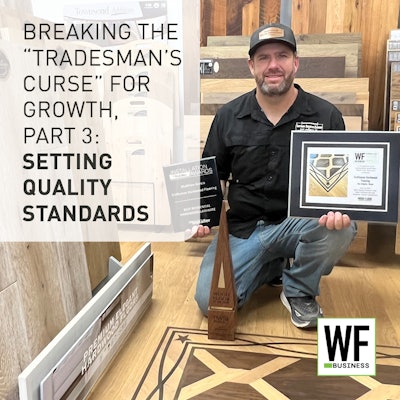
Do you ever hear people talk a big game only to find they can’t back it up? Here in Texas, they call it “Big hat, no cattle.” We are going to help you avoid becoming that person as you grow your company!
In this blog series we are outlining how to build a solid foundation for the management structure of your business (check out Part 1: Standard Operating Procedures and Part 2: Project Analysis if you didn’t already). A lot of what we will be digging into is how to incentivize performance for your team members. This is a combination of productivity and quality. Our next few blog posts will be about key performance indicators, score cards, and then performance pay. Quality standards should come first, or else the delicate balance of quality and productivity could be compromised.
The No. 1 way to incentivize quality is by creating a culture that reinforces the value for quality. Building a team that has integrity and pride in their work is pivotal. Integrity and excellence is part of our core values, so we hire for these qualities and train for the rest. The highest levels of respect and honor are given to the team members who go over the top to create excellent work and craftsmanship. We love to praise them on social media and congratulate them in front of other team members. Our clients hire us because they know we will treat their project as our own and create a work of art for them to enjoy for decades to come!
Things haven’t always been roses and perfect, of course. We’ve had to let go of employees who didn’t value quality or excellence. We don’t always hit the highest pinnacle of excellence, but we make sure every client is fully satisfied with the quality and go the extra for them if it isn’t. At times I would get frustrated or angry when I could see our quality standards slipping. I have found it is always best to take a minute, cool off, and go to the team member to offer training and encourage them about how we can do better—and how we can all win together, as we are all improving in different areas. Remind them that we want to support them in leadership and will provide them with resources to continually improve so they can hit their full potential!
Once a culture of quality is established, it becomes far less awkward to bring up ways to improve quality. We all know it’s a journey full of ways to improve—we don’t want to take personal jabs at each other, but we also don’t want to be afraid to have transparent conversations about how we can knock it out of the park for our clients.
How do you keep quality standards for subcontractors? There are definitely fewer options to maintain consistent quality standards using subcontractors, but you can still set expectations and use industry standards to provide accountability. You can encourage them to get training and/or require certifications. Ultimately, you decide whether or not to use them as a subcontractor if they cannot hit the quality standards your company requires.
Here are some ways to build a structure to manage quality control in your company:
Setting The standards: Both the sales/office side of the business and the field technicians need quality standards set in a way that helps them know what to shoot for and what is unacceptable. It can be problematic to have accountability for quality when the standards have not been officially documented.
Defining The standards: It’s great to get the team involved when defining what the standards of the company should be. You can discuss industry standards and the goals of the company to establish what the team should be held accountable for. The team will have a lot higher respect to enforce the standards if they help develop them.
Measure the quality: Now that you have set and defined the standards, you can measure them. Customer feedback forms are great, and they can rate your team. Reviews are also a great measure. You can do site evaluations that are graded. The team members can evaluate each other and or do self-evaluations. You can develop any or all of these tools to help create a management structure for your team. Be sure to give your team the resources they need to hit measurable goals.
Incentivize for quality: People inherently desire respect and appreciation when they do well. It’s encouraging to publicly show appreciation and celebrate when a team member goes above and beyond. Bonuses are a great way to show appreciation. High-quality team members can earn a higher wage and could get a bonus for positive reviews, positive client feedback and quality evaluations. They could earn points towards a monthly and/or quarterly bonus. There should be a healthy balance of pay that is reserved to reward for hitting quality standards.
If you need resources to build a quality control management structure, contact me and we can get you set up and on track! [email protected]
Stay tuned for our next blog post in this series, Part 4: Key Performance Indicators: How do you create them, and how can that help you take your business to the next level?
Editor's Note:
Be sure to read the WFB Magazine article “Building Systems to Break the ‘Tradesman’s Curse’ for Growth in Your Wood Flooring Business” and all of Matt's blog posts in this series:
Breaking the “Tradesman’s Curse” for Growth, Part 1: Creating Your Standard Operating Procedures
Breaking the 'Tradesman’s Curse' for Growth, Part 2: Project Analysis
Breaking the 'Tradesman’s Curse' for Growth, Part 3: Setting Quality Standards
Breaking the 'Tradesman’s Curse' for Growth, Part 4: Key Performance Indicators
Breaking the 'Tradesman’s Curse' for Growth, Part 5: Employee Scorecards
Breaking the 'Tradesman’s Curse' for Growth, Part 6: Performance Pay
Breaking the 'Tradesman’s Curse' for Growth, Part 7: The Power of Cash Flow


































